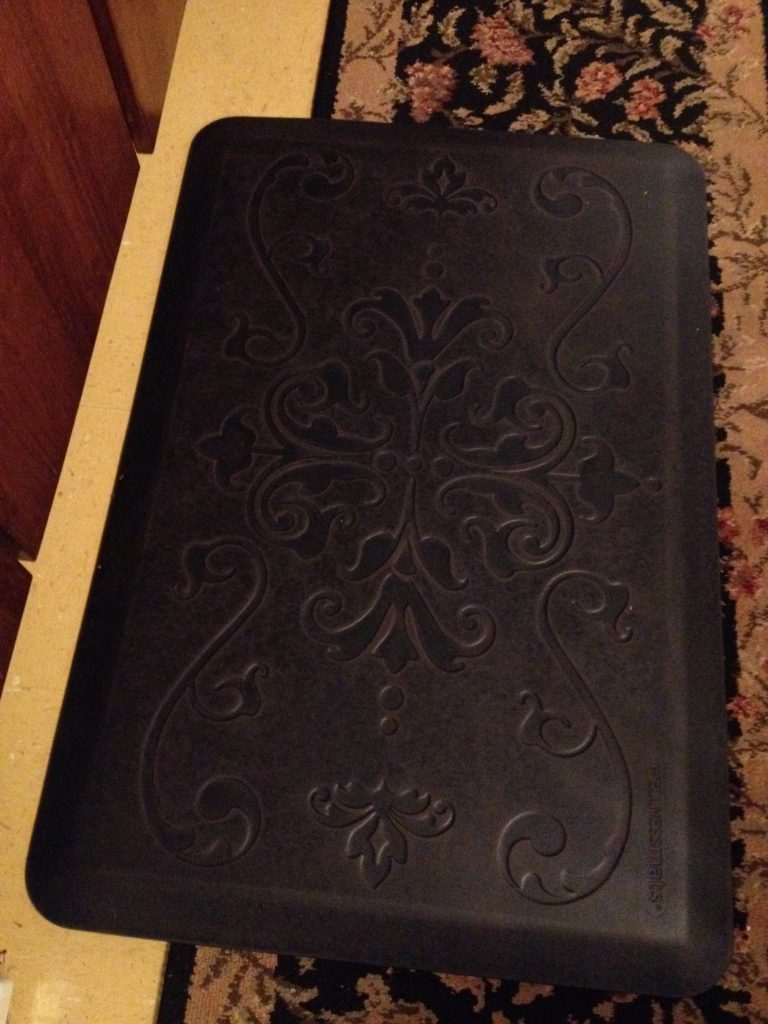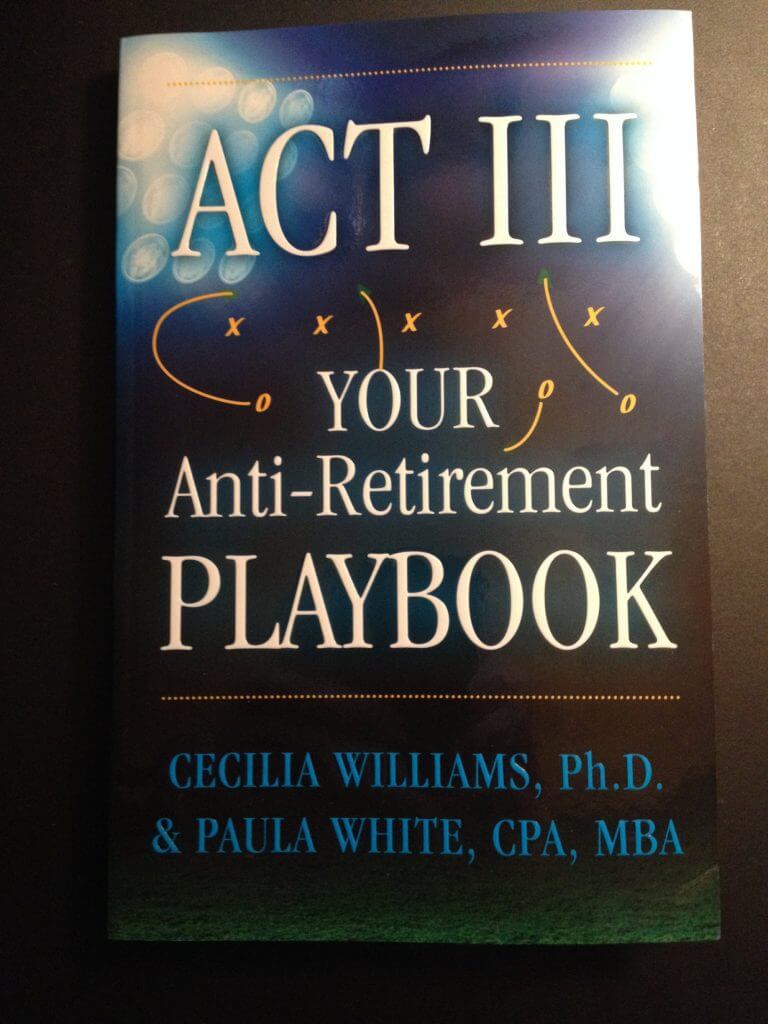Anti-fatigue mat. Feet hurt when you’re standing by the sink or the stove? Love to go barefoot when you cook, but it makes your legs ache? Recently received a sample of a super-cushiony anti-fatigue mat from Wellness Mats. It was a pleasant surprise to feel such firm-softness underfoot by the kitchen sink. The mats have beveled edges, come in multiple sizes, and are guaranteed for seven years not to curl—important to prevent falls—or deform or lose their cushiony-ness. Plus, they’re made 100% in the USA.
These mats ought to make a big difference in comfort for a bunch of scenarios. For example, if you:
- Don’t have a dishwasher—or just like washing dishes by hand
- Love to cook…
- Stand and fold laundry…
- Have a bad back or simply for better health want to use a standing desk…
- Want to cushion a hard seat at sports or entertainment events…
- Work at a tool bench on a concrete basement or garage floor…
- Kneel when you garden…
- Have to stand a lot when you travel…
- and so on.
You can buy cheaper mats, but most are more industrial-looking. These will go with almost any décor. Prices range from ~$70 for a small companion/travel size, ~$130 for a 2’x3’ professional-grade for medical, industrial apps, to $260 for a 6’x2’ mat from one of the designer collections. The designer collections are beautiful and look classy on your floor, almost like a sculpted rug. (Update 2/23/17: Be careful not to trip on this – even though it’s beveled at the edges, it’s thick and can definitely trip you up if you’re not paying attention. Also, take care not to fall off the edge when you’re side-stepping! See post here about using the mat for in-home exercise.)
_______________________________________
Book—Act III: Your Anti-Retirement Playbook. Received a review copy of this book and found it clearly written, easy to read, and full of positive ideas and practical tips for getting more out of life after retirement, along with a bit of history about the concept of retirement. Did you know the idea of retiring was introduced in most countries only in the late 19th century? Before that, people didn’t live all that long, and so mostly they just worked until they died. Lucky for many of us, we get to think creatively as we age about how we want to nurture our interests and even expand our relevance.
If you haven’t yet discovered the paths you want to take in this last part of life, this book uses mind mapping and questionnaires to help you discover your passions and set goals in the areas of technology, relevancy, relationships, health and finance. Sounds overwhelming, but don’t let this intimidate you. A quote from the book, “Find the smallest possible thing you can do to make an improvement and start with that.”
And even if you’ve already settled into a nice routine, the book may help you discover something new about yourself and what you care about. It takes a straightforward, no-nonsense approach to finding and pursuing your purpose in life—I think it would be good for anyone—even younger—who has free time and for whom the bills are mostly taken care of. Written by Cecilia Williams, PhD and Paula White, CPA, MBA. Price ~$15 ($9.99 for Kindle).
_______________________________________
Book—How Memory Works—and How to Make It Work for You. Are you lost without your smartphone? Can’t call your friends without speed dial? Never remember names? A review copy of this book reveals that its title is succinct and accurate—it contains a lot of scientific research about memory, explains a number of common tricks (acronyms, acrostics, rhymes) to sharpen mental skills, and gives practical tips to strengthen your memory as well as exercises to test yourself.
The author, Robert Madigan, PhD, says learning about memory is akin to walking rather than driving in the sense that “walking offers opportunities for self-reliance, healthy exercise, and personal satisfaction.” He details the following ideas for remembering something, saying you must:
- 1intend to remember it and have a plan for doing so (hmm, pay attention!);
- 2attach a deeper meaning to the item;
- 3add it to some existing memory;
- 4attach a visual image;
- 5associate it with another easier-to-recall memory;
- 6practice remembering it; and
- 7organize it, if possible, into categories (which automatically reinforces meanings you’ve attached per #2).
The chapter on “Remembering Life” may particularly appeal to anyone thinking of writing a memoir. Did you know that people over 50 tend to most vividly recall, except for very recent events, their memories from ages 15 to 30?
Though clearly written, this is a complex book. Not designed for a quick read but very good if you’re seriously into the topic. ~$12 paperback or e-book. $9.99 for Kindle.
_______________________________________
Book – The Noticer’s Guide to Living and Laughing: Change Your Life without Changing Your Routine, by Margery Leveen Sher, gives readers a light-hearted guide to paying attention to the ordinary people, places, things and events that make up a typical American life. Her premise is that we are overly scheduled and too much on our screens, that our anxiety is increasing, and that there’s a realistic solution. Her book relates anecdotes about her life and offers tips on how to enjoy and appreciate life more by truly noticing the things and people around us. She says “Noticers” seem to have less anxiety, experience more joy and make deeper connections.
Even though the author is a professional life-work-balance consultant, she writes in a cheerful, easygoing voice. The conversation-starter ideas in each sub-chapter consist of questions you ask and answer with grandparents, kids, friends or co-workers. Resulting discussions might be like little mini-workshops you conduct together. The ideas encourage talking to each other about simple things that are worth noticing—some cute, some tough (like how to act when we make a mistake), and some that are just there (like the stuff that accumulates in closets and junk drawers). She uses quotes from great authors and often suggests conversations based on content from books.
This one’s an easy read. Something you could keep on a shelf by the coffeepot to leaf through each morning and pick something to notice that day. Price ~$12 paperback, $6.99 Kindle.
_______________________________________
Book – Cookies & Beer: Bake, Pair, Enjoy by Jonathan Bender. Yes, you read it right: Cookies and beer. While this may seem like heresy, the more you read about it, the more sense it makes. Both things have important ingredients in common: grains, spices and fruits. The book points out how the perfect beer can bring out unexpected flavors in a cookie, and how the right cookie can awaken flavors hardly noticed before in a beer.
The cookie recipes are fascinating—some of them even include beer as an ingredient as in, for example, Rye IPA Apricot Crumble Bars, which are made up of an apricot-beer-lemon-maple-sugar compote, a rye-flour-sugar-butter shortbread, and a caraway-black walnut crumble. Isn’t your mouth watering just thinking about that? The chef’s notes say: “Rye beers (IPA or otherwise) will amplify the rye and caraway seeds in the bar cookie and tease out a bit of sweetness from the apricot filling.”
How about a beer milk shake? Made with vanilla ice cream, milk, chocolate syrup and beer syrup (made out of dark beer and raw sugar—the result of which can also be drizzled by itself over ice cream) sounds like a dessert that would love the company of almost any cookie. You’ve heard of pumpkin ale, right? Check out his recipe for Pumpkin Chocolate Chip Cookies served with Russian Imperial stout. The chef says: “When you add the stout to the cookie, it’s like you’ve just invented creamy pumpkin pie without the pie. The cookie pops up to lend lushness to this big, dark beer.”
You can tell this guy’s a food writer. This book is fun to read and dream about—even if you never make any of the recipes. Price ~$15, $9.99 for Kindle.


